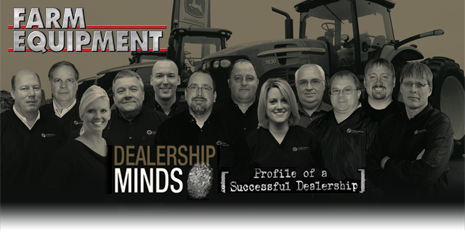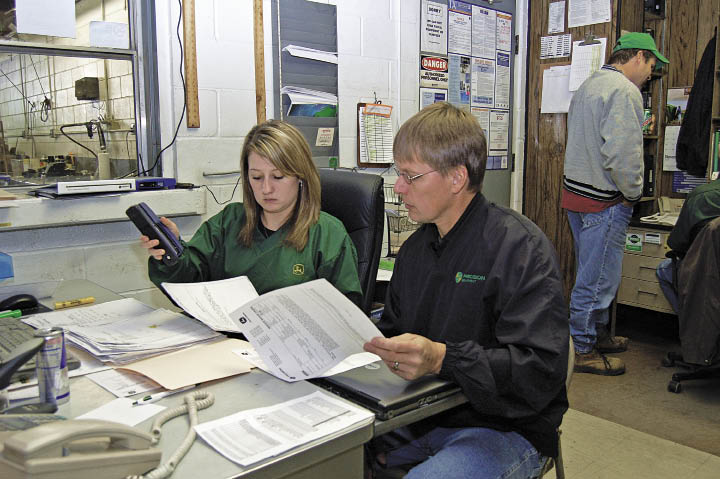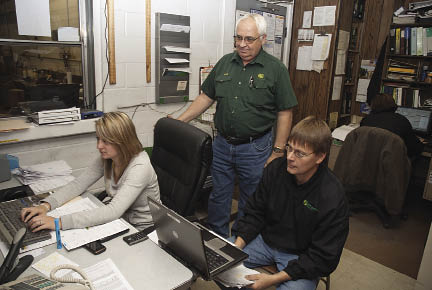

Location Manager (Durant, Iowa): Kevin Bland
Years with Organization: 25. After graduating from high school in 1983, Kevin Bland attended junior college for 2 years while working part-time as a technician at the Elder’s location at Durant. He then became a full-time technician in 1986. In 2002, he accepted the service manager’s position, and then applied for and received the position of location manager in 2010.
Role: To be the “go-to” person in the store, both for customers and for employees who have issues or concerns.
When Kevin Bland was 14 years old, he was hired to mow the lawn of the local farm equipment dealership in Durant, Iowa. Nearly 30 years later, he’s the location manager for the same dealership, now called Precision Equipment.
Just one year after taking over the top role at the former Elder Implement store, he’s learning success requires you to do what you’ve always done best. For Bland, that means providing top-notch service.
Having grown up at the dealership where his father was a manager, Bland was hired as a full-time service technician in 1986. Some 15 years later, he was promoted to service manager and then became location manager in 2010 when Elder decided that a dedicated store manager’s role was needed.
“There was a time when the dealership felt it could sustain itself without having a go-to person and they had it that way for a long time,” Bland says. “Over time, they felt that the customers were looking for a go-to person in the dealership — not only the customers, but employees, too!”
Use Your Strengths
Since Bland came from the “service” side of the business, it’s been only natural for him to gravitate toward his strengths in maintaining a high level of service to customers as the core to his location’s success.
In the meantime, he’s working toward learning the sales side of the dealership by leaning on those with sales experience at his location and throughout the company.
Clearly, a good location manager can’t live on an island. He needs to know his strengths and weaknesses and rely on others who have strengths that complement his own.
This shows up in a couple ways within the organization:
- “We have a diverse group of store managers. Each location manager has a different background,” Bland says. “I came from service, and we have a couple from the sales side. If I have a sales question, I can call on those guys about what they would do in certain situations. Likewise, they can call on me with their service issues.”
- “It was an easy transition from the service manager to the store manager, except for the fact I’m learning the sales side of the business,” he says. “I rely on my own salesmen. They know what they’re doing and they do it well. They help me out and I can help them out on some things. If they have service questions on a sales item, we work together.”
While Bland says his primary role as store manager is “having his branch succeed as an individual store,” it would be the wrong approach to focus solely on his store’s performance.
“While I’ve got to make sure that my branch succeeds in all areas of sales and service, we, as store managers, are all together as one group,” he says. “We look to each other to see what the best practices are.
“Maybe one location is doing something different. If we see that their practice is working better, we can put it out there at a manager’s meeting and discuss what is going on. If it turns out that it’s a better practice, then we can all use it at our own branch.”
Measured by the Matrix
While some store managers may tend to pore over the financial numbers at their location daily, Bland instead makes it a first priority each day to see whether there’s something that needs to be addressed from the senior leadership team, or whether John Deere has released any sales or service bulletins that require action.
 Kevin Bland (foreground), store manager for Precision Equipment's Durant, Iowa, location, spends a day at the Washington, Iowa, store helping train Brittany Mincks (left) and Alan Byerly on a new program that tracks work orders, purchases, billing and more with customers.
Kevin Bland (foreground), store manager for Precision Equipment's Durant, Iowa, location, spends a day at the Washington, Iowa, store helping train Brittany Mincks (left) and Alan Byerly on a new program that tracks work orders, purchases, billing and more with customers.
He’s responsible for providing a monthly financial report to the vice president of operations that provides the revenue numbers for his sales, parts and service departments, as well their 30- to 60-day goals. The store managers also hold monthly meetings to share concerns or opportunities that may lead to cooperative efforts between stores.
“At least once a week, we’ll look at the numbers at our location and see what service is doing, what sales is doing and what parts is doing to get a benchmark on where we’re at for the month,” Bland says. “We have a set goal that we try to hit for each department, and weekly reviews allow us to see how we’re matching up with that monthly goal.
“Our performance is measured on how all three departments perform. Since I came from service, it’s pretty easy for me to see where any service problems might be and where we stand. With parts, you can look at the parts sales. Naturally, if service is going well, your parts sales are going well, too. Of course, we can see our sales numbers and look at the margins we’re making.
“All that is put into a matrix and that reflects our overall performance.”
Strategies to Success
When it comes to the ingredients that make up a successful store location, Bland prefers to focus on the people — both his employees and his customers. Here are 5 strategies he focuses on:
1. Get the Right People. Bland says employees are the greatest asset to any business. “Without them, daily business just wouldn’t happen,” he says.
So Bland says it’s critical to have the correct employee for the position.
“Make sure they’re willing to do the things you ask of them. It’s fine if they question some things, but for the most part, you want them to do what you ask,” he says. “But you also want self-starters so you don’t have to watch over them.
“I look for someone who’s not afraid to get their hands dirty. You want somebody with a good personality that gets along well with the customer and is able to solve problems on their own, but who also fits within the company’s processes and goals.”
2. Help Employees Excel. While technicians receive incentives for completing work in a timely manner and salespeople receive commissions on sales, empowering employees to excel in their roles brings personal satisfaction.
Bland says technology is changing so rapidly that it’s critical that his technicians receive regular training. All employees, from the store clerks to administration to technicians, take Agriculture Management Solutions (AMS) training courses — the guidance, mapping, documentation, telematic systems and system components — so they have a basic understanding of how the technology works.
Salespeople go through dealer learning modules developed by Deere to help them know the features, functionality and benefits of the products they’re selling to get the right product in the customer’s hands.
And finally, when your employees are going the extra mile for the customer, make sure to do something to recognize that and motivate them.
“During harvest, we work from 7 a.m. to 6 p.m. on weekdays, 7 to 4 on Saturday and 8 to 1 on Sundays,” Bland says. “We’ll supply a meal on Saturday afternoon, and there’s typically enough food to carry over to Sunday as well. They’re there to help fix the breakdowns that occur in the field on the weekends. That helps a little bit and they enjoy that.”
3. Keep Customers Happy. Bland emphasizes that none of his employees like to see an unhappy customer. He says communication with farmers is vital in making sure issues are resolved fairly for both the customer and the store.
“Coming from the service side, you deal with customers’ problems every day because they’re bringing in something that’s broken. Sometimes they are not in the best of moods,” Bland says. “Basically, communication resolves issues. You want to be fair to the farmer but make sure you are being fair to the dealership as well. If you have a situation with a customer, I find that if you sit down with him or her and talk one-on-one and explain the situation, usually you can get the customer somewhat satisfied and leave him or her with a better feeling than when they came in.”
4. Treat Customers Equally. It’s natural and wise to immediately take care of the needs of a farmer who buys large volumes of equipment from your location. However, that doesn’t mean you push aside the smaller customer.
“They’re all important to us — every single customer out there,” Bland says. “It’s a matter of the service manager scheduling them in so every customer feels just as important as the next. We want them to leave satisfied with the work that was done or the core service or the sales effort they received.
“We have a gentleman who is not a big-acreage farmer, but his farm is important to him. He commented that we treat him just like we would the big farmer. My response was, ‘Well, why wouldn’t we? You’re as valuable a customer to us as the big-acreage farmer.’”
5. Follow Up with Customers. Through customer surveys conducted by Deere, Bland is able to get a good measurement of the performance of his departments and identify areas that need to be addressed.
Servicing new equipment sales — from making sure the customer is satisfied with the sales process and that his equipment is set up and operating properly — are critical areas store managers must focus on, he says.
“A big area of service is contact after the sales,” Bland says. “Within a week of the sale, we like to make contact with the customer; just a basic call to see how they are getting along with the new piece of equipment. We find out if there are any concerns or issues that need to be resolved. That contact with a customer goes a long way.
“We usually send a tech rep when they get started in the field and help them adjust the equipment or show how to operate it properly. Sometimes a salesman will pop in, too, or give them a call while they’re on the road to see how they are getting along.”




Post a comment
Report Abusive Comment